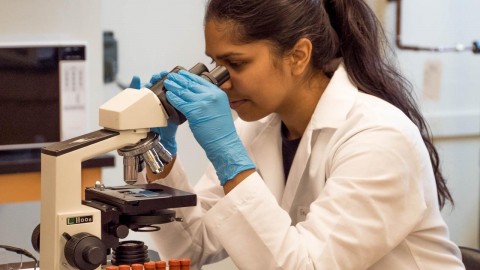Tuberculosis (TB) is a potentially serious infectious disease that mainly affects your lungs. The bacteria that cause tuberculosis are spread from one person to another through tiny droplets released into the air via coughs and sneezes.
Symptoms
- Latent TB. In this condition, you have a TB infection, but the bacteria remain in your body in an inactive state and cause no symptoms. Latent TB, also called inactive TB or TB infection, isn’t contagious. It can turn into active TB, so treatment is important for the person with latent TB and to help control the spread of TB. An estimated 2 billion people have latent TB.
- Active TB. This condition makes you sick and in most cases can spread to others. It can occur in the first few weeks after infection with the TB bacteria, or it might occur years later.
Signs and symptoms of active TB include:
- Coughing that lasts three or more weeks
- Coughing up blood
- Chest pain, or pain with breathing or coughing
- Unintentional weight loss
- Fatigue
- Fever
- Night sweats
- Chills
- Loss of appetite
Tuberculosis can also affect other parts of your body, including your kidneys, spine or brain. When TB occurs outside your lungs, signs and symptoms vary according to the organs involved. For example, tuberculosis of the spine may give you back pain, and tuberculosis in your kidneys might cause blood in your urine.
Causes
Tuberculosis is caused by bacteria that spread from person to person through microscopic droplets released into the air. This can happen when someone with the untreated, active form of tuberculosis coughs, speaks, sneezes, spits, laughs or sings.
Although tuberculosis is contagious, it’s not easy to catch. You’re much more likely to get tuberculosis from someone you live with or work with than from a stranger. Most people with active TB who’ve had appropriate drug treatment for at least two weeks are no longer contagious.
HIV and TB
Since the 1980s, the number of cases of tuberculosis has increased dramatically because of the spread of HIV, the virus that causes AIDS. Infection with HIV suppresses the immune system, making it difficult for the body to control TB bacteria. As a result, people with HIV are many times more likely to get TB and to progress from latent to active disease than are people who aren’t HIV positive.
Drug-resistant TB
Another reason tuberculosis remains a major killer is the increase in drug-resistant strains of the bacterium. Since the first antibiotics were used to fight tuberculosis more than 60 years ago, some TB germs have developed the ability to survive despite medications, and that ability gets passed on to their descendants.
Drug-resistant strains of tuberculosis emerge when an antibiotic fails to kill all of the bacteria it targets. The surviving bacteria become resistant to that particular drug and frequently other antibiotics as well. Some TB bacteria have developed resistance to the most commonly used treatments, such as isoniazid and rifampin.
Some strains of TB have also developed resistance to drugs less commonly used in TB treatment, such as the antibiotics known as fluoroquinolones and injectable medications including amikacin and capreomycin (Capastat). These medications are often used to treat infections that are resistant to the more commonly used drugs.
Risk Factors
Anyone can get tuberculosis, but certain factors can increase your risk of the disease. These factors include:
Weakened immune system: A healthy immune system often successfully fights TB bacteria, but your body can’t mount an effective defense if your resistance is low. A number of diseases, conditions and medications can weaken your immune system, including:
- HIV/AIDS
- Diabetes
- Severe kidney disease
- Certain cancers
- Cancer treatment, such as chemotherapy
- Drugs to prevent rejection of transplanted organs
- Some drugs used to treat rheumatoid arthritis, Crohn’s disease and psoriasis
- Malnutrition
- Very young or advanced age
Complications
Without treatment, tuberculosis can be fatal. Untreated active disease typically affects your lungs, but it can spread to other parts of your body through your bloodstream.
Examples of tuberculosis complications include:
- Spinal pain. Back pain and stiffness are common complications of tuberculosis.
- Joint damage. Tuberculous arthritis usually affects the hips and knees.
- Swelling of the membranes that cover your brain (meningitis). This can cause a lasting or intermittent headache that occurs for weeks. Mental changes also are possible.
- Liver or kidney problems. Your liver and kidneys help filter waste and impurities from your bloodstream. These functions become impaired if the liver or kidneys are affected by tuberculosis.
- Heart disorders. Rarely, tuberculosis can infect the tissues that surround your heart, causing inflammation and fluid collections that may interfere with your heart’s ability to pump effectively. This condition, called cardiac tamponade, can be fatal.
Prevention
If you test positive for latent TB infection, your doctor may advise you to take medications to reduce your risk of developing active tuberculosis. The only type of tuberculosis that is contagious is the active variety, when it affects the lungs. So if you can prevent your latent tuberculosis from becoming active, you won’t transmit tuberculosis to anyone else.
Homoeopathic Treatment
Kalium Carbonicum:
Common Name: Carbonate of potassium
Symptoms: Kalium carbonicum is advised for patients experiencing the following symptoms:
- Tendency to get tuberculosis
- Weakness with coldness, weak pulse and stitching chest pain
- Elderly people who have a tendency to get paralysis, swelling and obesity
- Chest pain, which gets worse while lying on the right side
- Dry, hoarse cough with stitching pain and dryness of the throat
- Cough that worsens at 3 am
- Scanty, sticky phlegm production that increases in the morning and after eating
- Wheezing and coldness in the chest
- Complaints are worse in the early morning, in cold weather, due to change of weather and while lying on the painful side. Symptoms improve in warm weather and by leaning forward
2. Lycopodium Clavatum
Common Name: Club moss
Symptoms: Lycopodium clavatum works well in children, the elderly and individuals who have an emaciated upper body and swollen lower body. It is indicated in cases of tuberculosis with the following characteristics:
- A tendency towards gastric and respiratory complaints
- A loud, rattling, deep cough
- Tickling sensation in the respiratory passage, as from sulphur fumes
- Breathlessness with constriction and burning pain in the chest
- Expectoration that is thick, pus-like, bloody, greyish, salty and provides little relief
- Cough that worsens at night and from going downhill, and improves after taking warm food and drinks
- Most symptoms are worse between 4 pm and 8 pm and typically affect the right side first
3. Phosphorus
Common Name: Phosphorus
Symptoms: Phosphorus is a remedy indicated for individuals who are lean and tall with stooped shoulders, delicate, anaemic and sensitive. It is indicated in tuberculosis in infrequent and cautious doses. Phosphorus is prescribed for tuberculosis with the following features:
- Congested lungs with a hard, dry and hacking cough
- Coughing up blood
- Rusty, red, pus-like expectoration that worsens in the morning and evening
- Trembling of the body while coughing
- A sensation of tightness across the chest and a feeling of weight on the chest
- Tickling sensation in the chest
- Throat pain while coughing
- A sensation of fatigue in the chest
- Breathlessness along with a feeling of heaviness and fullness in the chest
- Cough that gets worse while laughing, with a change of weather, strong odour, lying on the left side or on the back and from going into a cold room from a warm room
4. Pulsatilla Pratensis
Common Name: Windflower
Symptoms: Pulsatilla works on the nervous system and blood vessels. It is most suited to women and children who are slow, obese and weep easily. The complaints often come up at the time of puberty. Patients with the following symptoms respond well to Pulsatilla:
- Dry cough in the evening and at night that makes the person sit up in bed, and loose cough in the morning with profuse expectoration
- Thick, greenish and bitter expectoration
- Passing of urine while coughing
- Pressure and soreness in the chest region
- Pain as if there is an ulcer in the middle of the chest
- Suffocating sensation on lying down
- Breathlessness, palpitations and anxiety while lying on the left side
- Lack of thirst
- Symptoms are worse in a closed and warm room and better in open and cold air
5. Silicea Terra
Common Name: Silica, pure flint
Symptoms: Silicea is prescribed to tuberculosis patients who are pale, weak, feel extremely cold and have improper nutrition due to imperfect assimilation. This remedy helps to resorb the fibrous and scar tissue and is indicated for the following conditions:
- A tendency to get swollen glands
- Cough with profuse, yellow, lumpy, bloody sputum that contains pus and mucus
- Expectoration in granular form with an offensive odour
- Cough with stitching pain in the chest
- Cough that gets worse while lying down
- Tuberculosis of the spine (Pott’s spine)
6. Spongia Tosta
Common Name: Roasted sponge
Symptoms: Spongia Tosta is given to tuberculosis patients with the following symptoms:
- A tendency to swollen glands and cardiac complaints
- Anxiety and exhaustion after the slightest exertion, and a rush of blood to the face and chest
- Dry, hacking, barking cough
- Plug-like sensation in the throat
- A sensation of a sore spot in the chest which brings on the cough
- Extreme dryness of the air passages
- Wheezing and suffocated feeling with sudden weakness
- Cough that gets worse at midnight, with deep inspiration, mental exertion, eating sweets, smoking, reading, talking, swallowing, laying the head low and during dry cold winds, and better after food or drink, especially warm drinks
7. Stannum Metallicum
Common Name: Tin
Symptoms: Stannum metallicum is well suited to individuals with the following characteristics and symptoms of tuberculosis:
- Extreme weakness and debility
- A sensation of weakness in the throat and chest while talking
- Violent and dry cough in the evening until midnight along with weakness, soreness and an empty sensation in the chest
- Deep, hollow, strangling cough in paroxysms of three coughs
- Need to cough forcefully to expel mucus
- Profuse, thick, green and sweetish expectoration that is produced usually during the day
- Short, suffocating respiration with stitching pain in the chest on the left side
- Tuberculosis with fever
- Cough that gets worse while talking, laughing, singing, in bed and while lying on the right side, and improves after expectoration
8. Tuberculinum Bovinum
Common Name: Pus (with bacilli) from the tubercular abscess
Symptoms: Tuberculinum bovinum is a remedy indicated in cases of tuberculosis. It is suited to individuals who are lean, emaciated, get tired easily, take longer to recover from illness and are sensitive to change of weather. It is prescribed to people who have the following symptoms:
- Presence of tubercular deposits on the apex of the lung, especially on the left side
- Dry, hard cough with profuse sweating and rales, or clicking or rattling lung sounds
- Profuse and thick expectoration
- Breathlessness and suffocation
- Cough that is worse at night and during sleep
- A desire for fresh and cold air











